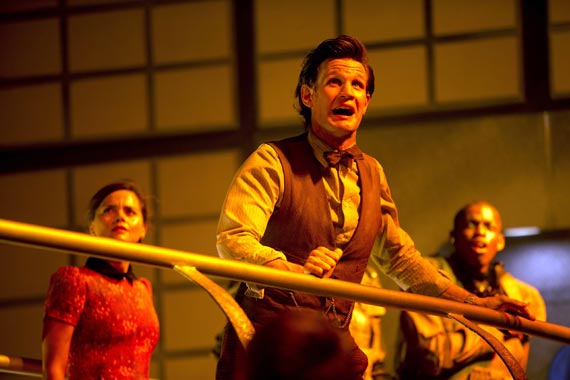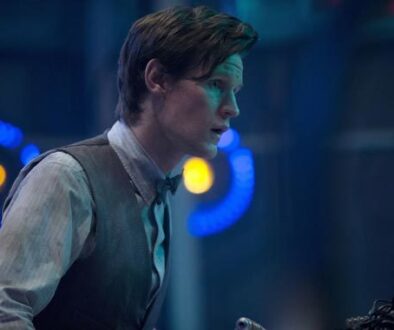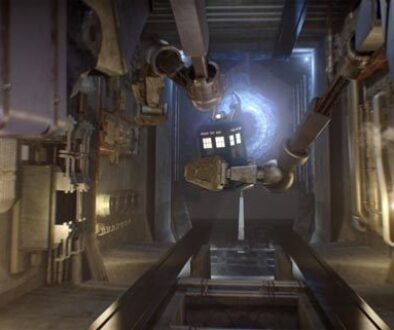Journey to the Centre of the TARDIS Review
Clint Hassell reviews Steve Thompson’s latest episode.
Just to be upfront: I hated “Journey to the Centre of the TARDIS.” Hated. In fact, in trying to find a more disappointing episode of Doctor Who, I rewatched Series 2’s “Fear Her,” and found I loved it by comparison. That’s right: “Journey to the Centre of the TARDIS” is so bad, I now like “Fear Her.” [shudder]
In fairness, I can admit that “Journey to the Centre of the TARDIS” does have some nice moments – which I promise to honor* – and that my disdain could stem from the fact that the episode seems a sad sequel to “The Doctor’s Wife” (my previous most-hated episode of Who, though, admittedly, more on principle than on the episode’s merits). For me, “Journey to the Centre of the TARDIS” sits at the center of the Venn diagram of “lazy, nonsensical writing” and “disappointing execution of premise.”
*Want to skip directly to my compliments for this episode and a bit of fun speculation? Scroll down to the photo of Eleven entering the time rift. Everyone else, let’s have some tongue-in-cheek fun at this episode’s expense! (Hey, “my ship, my rules,” right?)

If the Doctor is still suspicious of Clara, then why in the name of Gallifrey would he teach her to fly the TARDIS?
Obviously, Jenna-Louise Coleman has never burned her hand before as she portrays Clara gingerly blowing on what is later revealed to be branded flesh. Clara even grabs the Doctor’s hand at one point and doesn’t wince in pain. Is she not human?
How could Clara have recognized the Doctor’s real name? “A Good Man Goes to War” revealed that the TARDIS doesn’t translate Gallifreyan script, so, either Clara is fluent in Gallifreyan, or The History of the Time War was written in English – and that’s just silly.
Further, when the Doctor (finally!) confronts Clara as to her identity, Clara admits that she is “more scared of [him] right now than anything else on that TARDIS” – so terrified of him, apparently, that she must hug him, and then continue to place her trust (and life) in his care. Does Clara have Stockholm syndrome?

The “joke” Gregor and Bram play on Tricky creates so many problems, I don’t even know where to begin. During his recovery, did not one single physician say to Tricky, “Gosh, I’m sorry about the loss of your dad. Luckily, you’ve still got your brothers. Now, let’s discuss the maintenance of your new bionic eyes”? Are we to believe that Tricky never questioned his continuing need to eat, breathe, or use the bathroom? Has he not cut himself shaving and realized that he does, in fact, feel pain? Further, why does Tricky continue to recite his “no fear, no hate, no pain” mantra – even using it as logic for Gregor to cut his arm off – while grimacing in pain from being pinned to a wall? (And, why does it take the Doctor to tell Gregor to cut through the metal rod instead of Tricky’s arm?) Is Tricky really this dim-witted? If so, then I question his dad’s decision to make him captain of the family’s salvage vessel. No wonder Gregor was upset!
Most surprising is that, despite the Van Baalen brothers’ literally inhumane treatment of Tricky – and, let’s be honest, theirs is a betrayal of Biblical proportions – the Doctor barely admonishes Gregor for his cruelty, later almost defending Gregor’s “one, tiny scrap of decency.” How unlike the Doctor! Does anyone else remember the tongue-lashing the Doctor gives “Colonel Runaway,” in “A Good Man Goes to War”?

The Doctor claims that, “after a minute or two” in the presence of the Eye of Harmony, “our cells will liquefy and our skin will start to burn.” Yet, once inside, he stops to give a 16-second physics lesson as to the Eye’s nature. That makes sense, right?
In fact, that entire scene is rife with problems as the Doctor spends approximately 4 minutes and 40 seconds in the Eye’s presence, with no ill effects. The Van Baalen brothers, however, change into Time Zombies at about 3 minutes and 15 seconds. This could just indicate that the Doctor is more resistant to the Eye’s harmful effects, and that he underestimated the time that one could withstand the Eye’s energies… except that Clara, who entered the room before the Van Baalens, also survives, with no ill effects. Could it be that the Van Baalen brothers only transformed in response to their fulfilling time’s prophecy by touching? Maybe, but then why did the Doctor not zombify when he touched his own face? And, how did zombification not cause the Doctor to regenerate? I mean, Six regenerated into Seven because of space turbulence.
How are the Pyroviles Time Zombies even alive? Their flesh is so charred as to be crusty with ash, yet they are capable of functioning as killing machines? What motive did Zombie Clara have for killing Bram?

Where the additional “echo” control rooms necessary? Couldn’t the TARDIS reconfigure itself to guide the Doctor and Clara together? The TARDIS changes its layout to isolate Gregor and his stolen TARDIS circuit from the Doctor and Tricky (only to allow them to reconvene just as the Doctor needs Gregor’s “intelligent sensor,” but I digress). Also, if the Doctor can hear Clara, and see her shadow, why can’t he manage to locate her within the control room? After “Silence in the Library,” shouldn’t the Doctor be better at following shadows? Finally, did the Doctor basically teleport Clara from one echo control room to another, using the sonic? I give up – the sonic is a magic wand now. “Teleportus magicus!”
Despite knowing that the TARDIS can reconfigure its form as a protective mechanism, it never occurs to the Doctor that the void-y chasm isn’t real? (At first, I figured that the Doctor was using the illusion as a ruse to pressure Clara into revealing her true identity. Apparently not.) We’ve seen multiple instances where the Doctor appears knowledgeable of the TARDIS’ inner-workings and capable of their repair, yet he is surprised by this security feature? Sure, the Doctor’s TARDIS-tinkerings may be akin to my being able to change the oil in my car but not knowing how to fix its transmission. However, I am at least aware that I my car doesn’t have an illusion-generating security system. (Sadly, that is not a standard feature on a Toyota Corolla.)

What I did like (as promised*):
- the spectacular effect of the Van Baalen brothers’ salvage ship flying through space.
- the teaser’s uncut shot of the Doctor and Clara pacing around the TARDIS’ center console.
- as they begin, the opening credits shake to match the captured TARDIS inside the magno-grab.
- the inventive laser chainsaw.
- the Doctor’s cot, Amy’s papier-mâché TARDIS, and Seven’s umbrella!
- the Architectural Reconfiguration Room is hauntingly beautiful and reminiscent of a tree of life – a subtle way to reinforce that the TARDIS is alive.
- Susan, Three and Jo, Eleven and Idris, Four, Nine, Amy, Martha, and Ian! While the literal echoes serve mostly as Easter eggs, they actually contained sound bites perfectly chosen to convey the TARDIS’ nature.
Despite the publicity the mystery is receiving, millions of viewers do not tune into Doctor Who each week to see if the Doctor’s name is finally revealed. While a mystery like that might hold an audience’s attention for a few weeks, it couldn’t develop the following attained by Doctor Who. While I do appreciate the underlying secrets regarding the Doctor’s real name – and even the occasional hints as to it’s true form – to me, it’s a very minor aspect of the show, and I’m glad that Doctor Who has developed beyond Ian’s initial “Doctor who?” quip from the first serial.
That being said, let me pose a question: if you absolutely had to select a name for the Doctor – no whispered secret, no written-in-Gallifreyan cheat, no “it’s unpronounceable by humans” caveat – what would you choose?
My first thought was “Carmen,” which is Latin for “song.” Music has been important to each incarnation of the Doctor, and is one of the few consistencies in his character between regenerations. Further, the choice would allow the Doctor and his “wife,” River, to share a name. That being said, I don’t see the Doctor as a “Carmen.”
I would pick “Sagittarius,” which can be translated from Latin as “adventurer,” and would immediately bring to mind images of traveling amongst the stars. Double bonus: as the zodiac sign Sagittarius covers November 22 through December 21, the premiere dates of Season 1 (November 23, 1963) and the finale of Season 26 (December 6, 1989) are both covered, paying homage to the classic series.








